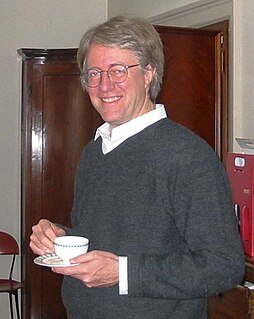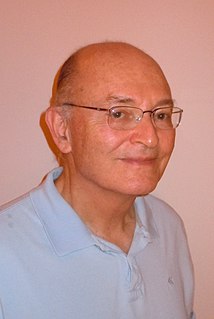Related Research Articles

Chaos theory is an interdisciplinary scientific theory and branch of mathematics focused on underlying patterns and deterministic laws highly sensitive to initial conditions in dynamical systems that were thought to have completely random states of disorder and irregularities. Chaos theory states that within the apparent randomness of chaotic complex systems, there are underlying patterns, interconnectedness, constant feedback loops, repetition, self-similarity, fractals, and self-organization. The butterfly effect, an underlying principle of chaos, describes how a small change in one state of a deterministic nonlinear system can result in large differences in a later state. A metaphor for this behavior is that a butterfly flapping its wings in Brazil can cause a tornado in Texas.

Murray Gell-Mann was an American physicist who received the 1969 Nobel Prize in Physics for his work on the theory of elementary particles. He was the Robert Andrews Millikan Professor of Theoretical Physics Emeritus at the California Institute of Technology, a distinguished fellow and one of the co-founders of the Santa Fe Institute, a professor of physics at the University of New Mexico, and the Presidential Professor of Physics and Medicine at the University of Southern California.

Ralph Herman Abraham is an American mathematician. He has been a member of the faculty of the University of California, Santa Cruz since 1968.

Martin Charles Gutzwiller was a Swiss-American physicist, known for his work on field theory, quantum chaos, and complex systems. He spent most of his career at IBM Research, and was also an adjunct professor of physics at Yale University.
Jack Wisdom is a Professor of Planetary Sciences at the Massachusetts Institute of Technology. He received his B.S. from Rice University in 1976 and his Ph.D. from California Institute of Technology in 1981. His research interests are the dynamics of the Solar System.

Andrei Dmitriyevich Linde is a Russian-American theoretical physicist and the Harald Trap Friis Professor of Physics at Stanford University.

Mitchell Jay Feigenbaum was an American mathematical physicist whose pioneering studies in chaos theory led to the discovery of the Feigenbaum constants.

J. Doyne Farmer is an American complex systems scientist and entrepreneur with interests in chaos theory, complexity and econophysics. He is a Professor of Mathematics at Oxford University, where he is Director of the Complexity Economics at the Institute for New Economic Thinking at the Oxford Martin School, and is also an external professor at the Santa Fe Institute. His current research is on complexity economics, focusing on systemic risk in financial markets and technological progress. During his career he has made important contributions to complex systems, chaos, artificial life, theoretical biology, time series forecasting and econophysics. He co-founded Prediction Company, one of the first companies to do fully automated quantitative trading. While a graduate student he led a group that called itself Eudaemonic Enterprises and built the first wearable digital computer, which was used to beat the game of roulette.
William Lionel Burke was an astronomy, astrophysics, and physics professor at UC Santa Cruz. He is also the author of Spacetime, Geometry, Cosmology (ISBN 0-935702-01-6), and of Applied differential geometry (ISBN 0-521-26929-6), a text expounding the virtues of differential forms over vector calculus for theoretical physics.

Norman Harry Packard is a chaos theory physicist and one of the founders of the Prediction Company and ProtoLife. He is an alumnus of Reed College and the University of California, Santa Cruz. Packard is known for his contributions to both chaos theory and cellular automata. He also coined the phrase "the edge of chaos".

David Pierre Ruelle is a Belgian mathematical physicist, naturalized French. He has worked on statistical physics and dynamical systems. With Floris Takens, Ruelle coined the term strange attractor, and developed a new theory of turbulence.

Predrag Cvitanović is a theoretical physicist regarded for his work in nonlinear dynamics, particularly his contributions to periodic orbit theory.
Daniel L. Stein is an American physicist and Professor of Physics and Mathematics at New York University. From 2006-2012 he served as the NYU Dean of Science.
The Eudaemons were a small group headed by graduate physics students J. Doyne Farmer and Norman Packard at the University of California Santa Cruz in the late 1970s. The group's immediate objective was to find a way to beat roulette using a concealed computer, but a loftier objective was to use the money made from roulette to fund a scientific community. The name of the group was inspired by the eudaimonism philosophy.

Miguel Angel Fernández Sanjuán is a Spanish Theoretical Physicist from Leon, Spain. He is known for his contributions in nonlinear dynamics, chaos theory, and control of chaos, and has published several scientific papers and popular news articles. He has supervised around 20 PhD students in Nonlinear Dynamics, Chaos and Complex Systems.
James P. Crutchfield is an American mathematician and physicist. He received his B.A. summa cum laude in Physics and Mathematics from the University of California, Santa Cruz, in 1979 and his Ph.D. in Physics there in 1983. He is currently a Professor of Physics at the University of California, Davis, where he is Director of the Complexity Sciences Center—a new research and graduate program in complex systems. Prior to this, he was Research Professor at the Santa Fe Institute for many years, where he ran the Dynamics of Learning Group and SFI's Network Dynamics Program. From 1985 to 1997, he was a Research Physicist in the Physics Department at the University of California, Berkeley. He has been a Visiting Research Professor at the Sloan Center for Theoretical Neurobiology, University of California, San Francisco; a Post-doctoral Fellow of the Miller Institute for Basic Research in Science at UCB; a UCB Physics Department IBM Post-Doctoral Fellow in Condensed Matter Physics; a Distinguished Visiting Research Professor of the Beckman Institute at the University of Illinois, Urbana-Champaign; and a Bernard Osher Fellow at the San Francisco Exploratorium.
Celso Grebogi is a Brazilian theoretical physicist who works in the area of chaos theory. He is one among the pioneers in the nonlinear and complex systems and chaos theory. Currently he works at the University of Aberdeen as the "Sixth Century Chair in Nonlinear and Complex Systems". He has done extensive research in the field of plasma physics before his work on the theory of dynamical systems. He and his colleagues have shown with a numerical example that one can convert a chaotic attractor to any one of numerous possible attracting time-periodic motions by making only small time-dependent perturbations of an available system parameter. This article is considered as one among the classic works in the control theory of chaos and their control method is known as the famous O.G.Y. method. He was listed in the 2016 Thomson Reuters Citation Laureates.

Edward Ott is an American physicist most noted for his contributions to the development of chaos theory.
References
- ↑ LCCN
- ↑ The John D. And Catherine T. MacArthur Fellowship, List of 1988 MacArthur Fellows "Archived copy". Archived from the original on 2010-02-12. Retrieved 2010-02-06.CS1 maint: archived copy as title (link)
- ↑ Robert Shaw, The Dripping Faucet As a Model Chaotic System, Science Frontier Express Series, Aerial Press, December 1984, December 1984 ISBN 0-942344-05-7 full text from archive
- ↑ James Gleick, Chaos: Making a New Science
- ↑ Strange Attractors: a movie for curious people (film)
- ↑ The Eudaemonic Pie by Thomas A. Bass ISBN 0-595-14236-2